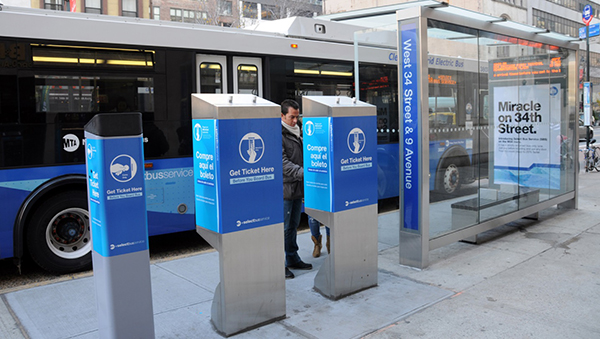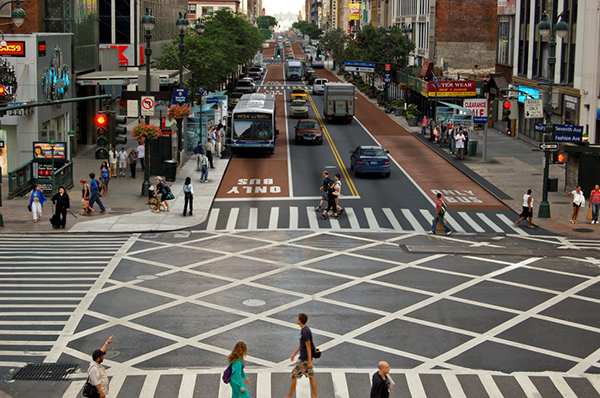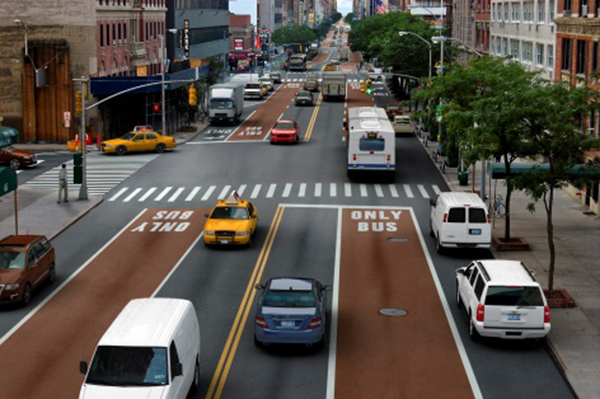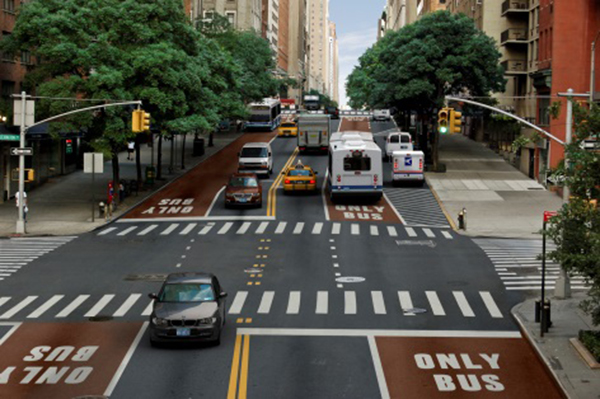34th Street Select Bus Service
M34/M34A Select Bus Service began on November 13, 2011
Overview | Updates | Design | Community Outreach and Reports | Timeline
Overview
The 34th Street (M34/M34A) Select Bus Service project was undertaken to address three major issues facing the two-mile corridor: slow bus service, crowded sidewalks, and a projected population and employment growth of 750,000 workers and 20,000 residents resulting from developments like the Hudson Yards and Moynihan Station.
Prior to the 34th Street Select Bus Service, the corridor, which extends from the 34th Street Ferry Terminal on the East River to Twelfth Avenue, was served by two lines: the M16 and the M34. Combined the two lines carried over 17,000 passengers daily but travelled at an average speed of just 4.5 miles per hour, only slightly faster than walking. With over 100 transit buses per hour travelling the corridor, commuter buses carrying over 16,000 passengers daily, and hundreds of tour buses navigating 34th Street throughout the course of the day, the corridor experienced consistent traffic with especially heavy traffic during peak hours. In addition, the corridor serves the Javits Center, NYU Langone Medical Center, Penn Station, and other key destinations.
The 34th Street Select Bus Service project provided the New York City Department of Transportation (DOT) and New York City Transit (NYCT) the opportunity to engage with residents and businesses along the two-mile corridor. Together, they were able to establish ways to improve traffic conditions, transit speeds, and pedestrian safety, and to expand curb access and loading along 34th Street.
Updates
New improvements to 34th Street, providing faster buses and safer streets.The 34th Street Select Bus Service project is being built in three parts: the West Section, Middle Section, and East Section
West Section: 34th Street from Twelfth Avenue to mid-block between Eighth and Seventh Avenues.
Work in this section includes six bus bulbs, repaving and restriping, a new bus lane, and loading zones.
As of the end of 2014, five of the six bulbs were completed, three of which are open to service. Paving and striping has also been completed. The planned bus bulb at Eighth Avenue NW could not be completed due to scaffolding interference in front of the New Yorker Hotel. This location will be completed after the scaffolding is removed. The two bulbs between Eleventh and Tenth Avenues were completed as a part of the larger Hudson Yards park and boulevard capital project, managed by the Hudson Yards Development Corporation. They will open for service once the other construction at those locations is completed.
Middle Section:This section encompasses 34th Street from mid-block between Eighth and Seventh Avenues to Lexington Avenue and includes four bus bulbs, repaving and restriping, a new bus lane, and loading zones. This section is actively in construction and is managed by MTA New York City Transit. The work is projected to be completed in 2015.
East Section: This section encompasses 34th Street from Lexington Avenue to the FDR Service Road. Construction began in spring 2014 and is managed by the New York City Department of Design and Construction. Construction is expected to last 30 months and begins with the installation of a new sewer and a distribution water main between First and Third Avenues. This work is related to the City Water Tunnel No. 3 project.
Following sewer and water main work, this section will include three bus bulbs, repaving and restriping, a new bus lane, and loading zones. DDC will provide more information and schedule updates to the community as it becomes available.
Design
The design of the 34th Street Select Bus Service is based on DOT's analysis of the traffic, transit, and curbside access needs on the corridor. It was developed after extensive community outreach, including discussions with local residents, businesses, and institutions, and a rigorous traffic analysis.



Traffic Analysis
DOT conducted a comprehensive traffic analysis for the project that analyzed 34th Street as well as surrounding streets. The results of the analysis were presented to the public in September and October of 2011. Overall, DOT found that traffic congestion will remain roughly the same with the addition of the project, while increasing bus speed and reliability.
Alternatives Analysis
The proposed set of improvements was identified by the 34th Street Transit Corridor Alternatives Analysis study.
Community Outreach and Reports
Community involvement was and still is a central part of the planning for the project. DOT and NYCT regularly consulted a Community Advisory Committee, holding public forums, and directly reaching out to key stakeholders along the corridor.
Community Advisory Committee
DOT and NYCT convened a Community Advisory Committee to provide guidance for the 34th Street Select Bus Service project. The committee met throughout the project planning phase and was comprised of a broad range of stakeholders, including elected officials, Community Boards, community groups, and major area institutions.
June 15, 2010 September 21, 2010 January 18, 2011 March 14, 2011 September 27, 2011 March 28, 2012Community Board Meetings
DOT and NYCT presented to Manhattan Community Boards 4, 5, and 6 on multiple occasions throughout the project's planning stages. Community Board 4April 16 and Dec 17, 2009
Presentation to the Transportation Committee April 18, 2012 Community Board 5
April 21, 2008 March 31, 2010
June 21, 2010
Presentation to the Transportation Committee and review of next steps
May 5, 2008
Presentation to full board
January 3, 2011
Presentation to full board
Presentation to full board
Public Open Houses
Public open houses take place at key points to involve the larger public. The open house format allows the public to have one-on-one conversations with project principals and review and comment on preliminary design plans for 34th Street. DOT and NYCT held five open houses throughout the course of the project.
Community Forums on Curbside Access
To learn about the block-by-block curb use needs of 34th Street, DOT and NYCT hosted a series of forums in October and November 2010. These forums provided the building owners and managers, residents, and businesses of 34th Street a chance to learn about the 34th Street project and provide information on their individual curb use needs. DOT and NYCT also encouraged stakeholders of 34th Street who could not attend a forum to take an online survey to provide information on curb use activity. DOT also reached out directly to building owners and building managers to learn about specific curb access needs.
Community Feedback Summary
In addition to these meetings, DOT and NYCT met with a number of project stakeholders, including local elected officials, building owners, and community groups, to solicit further feedback. Read the report summarizing the comments, questions, and suggestions that we received from community residents, business and building owners, local organizations, elected officials, and others.
Environmental Review
The 34th Street Select Bus Service project, as a recipient of federal funding, is subject to the National Environmental Policy Act (NEPA) and is required to undergo a federal environmental review. The Federal Transit Administration (FTA), which is overseeing the federal environmental review for the project, initially directed DOT to prepare an Environmental Assessment. An Environmental Assessment evaluates whether or not a project will have significant environmental impacts and typically examines a wide range of environmental, social, and economic topics. Under NEPA rules, an agency that is proposing a project is required to release an Environmental Assessment for public review and comment.
After further review during fall 2011, the FTA determined that the 34th Street Select Bus Service project qualified for a Categorical Exclusion (CE) instead of an Environmental Assessment. A CE is issued when a project includes elements that the agency routinely constructs as part of its normal operations. The FTA made this change based on the revisions to the scope and design of the project that resulted from community input. The project includes standard Select Bus Service elements such as sidewalk extensions and offset bus lanes, and the analysis showed that the project would not have any significant traffic impacts. The FTA approved the CE on December 29, 2011, concluding the federal environmental review for the project. The FTA does not issue an environmental review document as part of the CE process.
DOT has a long standing pledge to share with the public the detailed analysis of the project, including the transportation and air quality analysis. Therefore, DOT prepared a Project Analysis Report on the 34th Street project. This report covers a wide range of topics, including transportation, social, and other environmental impacts. In preparing this document, DOT followed the methodologies of the City Environmental Quality Review (CEQR) Technical Manual, the same guidelines that were followed in the preparation of the Categorical Exclusion. However, this document is not an official environmental impact study under NEPA or CEQR.
Timeline
2008Meetings with Community Boards and organization of multiple open house to discuss 34th Street bus issues Implementation of extended bus lanes between Ninth Avenue and First Avenue, and upgrading of existing bus lanes between Eleventh Avenue and Ninth Avenue 2009
Beginning of community discussion and evaluation of alternatives for further improvements along 34th Street Pilot of real time bus arrival information 2010
Continued community participation efforts by DOT and NYCT, including reaching out to residents, business owners, building managers, and institutions to convene community forums Development of a comprehensive traffic model to analyze potential traffic impacts Environmental review and traffic analysis initiated 2011
Development of a preliminary corridor design based on community feedback Comprehensive traffic analysis completed and Project Analysis Report released Convening of Community Advisory Committee and community forums to present the preliminary design and traffic analysis and solicit feedback November 13, 2011: Service began, including fare pre-payment, on the M34/M34A Select Bus Service 2012
Community Advisory Committee convened to discuss proposed curb regulations on 34th Street and the project construction schedule Completion of final design for the capital elements of the project Bus bulb construction began at:
- Eleventh Avenue SE (eastbound)
- Eleventh Avenue NE (westbound)
Completion of 2012 bulbs Bus bulb construction began at:
- Tenth Avenue SE (eastbound)
- Ninth Avenue SE (eastbound)
- Eighth Avenue SE (eastbound)
- Seventh Avenue SW (eastbound))
- Sixth Avenue SE (eastbound))
Completion of Tenth Avenue SE, Ninth Ave SE, and Eight Avenue SE bulbs Bus bulb construction began at:
- Fifth Avenue SE (eastbound)
- Park Avenue NW (westbound)
Completion of Seventh Avenue SW, Sixth Avenue SE, Fifth Avenue SE, and Park Avenue SW bulbs Repaving of road from mid-block between Eighth and Seventh Avenues to Lexington Avenue Implementation of offset bus lanes from mid-block between Eighth and Seventh Avenues to Lexington Avenue Addition of parking/loading space from mid-block between Eighth and Seventh Avenues to Lexington Avenue 2016
Completion of Eighth Avenue NW (westbound) bulb Completion of East Section (Lexington Avenue to FDR Service Road) managed by DDC

